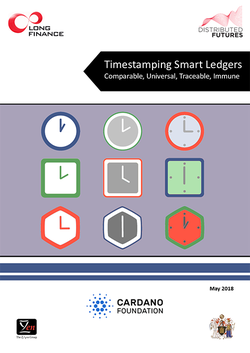Press Release: Researchers Bring Atomic Clock Timestamp Precision To Stock Market Trading Over Distributed Ledgers
Thursday, 24 August 2017
In a ground-breaking experiment, researchers from the National Physical Laboratory, the Toronto Stock Exchange (TMX), and Z/Yen, timestamped financial stock trades with Co-ordinated Universal Time (UTC) generated from atomic clocks and recorded the trades directly on a distributed ledger. The results will be analysed by Strathclyde’s Centre of Financial Regulation and Innovation. The “Atomic Ledger” project recorded over 20 million transactions from three hours of trading to the ChainZy distributed ledger system.
Distributed ledger (aka blockchain) technology is one of the core technologies of the new Fintech movement. Distributed ledgers enable financial market counterparties to store financial assets in a shared ledger. The team created a timestamping engine using Z/Yen’s woven-broadcasting distributed ledger architecture to test the recording of high-frequency trading transactions.
Existing financial market "clock synchronization and time stamp requirements" mandate that both trading venues and market participants synchronize their clocks to Co-ordinated Universal Time (UTC). That said, different processing speeds, server capabilities and execution code can result in digitally programmed orders arriving at a market place at different times.
The Markets in Financial Instruments Directive (MiFID II) EU legislation comes into force on 3 January 2018 for firms who provide financial services. The directive mandates more accurate timestamping traceable to UTC to promote improved transparency and better deals for customers. Current regulatory guidance suggests that trades need to be recorded in microseconds (a millionth of a second).
The test used nanosecond resolution high-frequency data from the TMX located in Interxions’s London Data Centre with support from Hyperneph. The researchers timestamped digital orders of varying programing length written to execute a series of buy and sell instructions. These were either logged with NPLTime®, using the atomic clocks at NPL, or logged with UTC plus a randomly generated time lag. The orders were then sent to a central clearinghouse also operating on UTC and written onto a ChainZy distributed ledger.
Further research by NPL and Strathclyde Business School will analyse the importance of timing in how orders are ‘cleared’. The results will provide insights into the need for precision timestamping in financial transactions, preferably at the microsecond level. The conclusions will prove useful for regulatory and financial market participants. It is believed the results will provide a benchmark to incorporate the concept of timing into financial asset price discovery.
Leon Lobo, Strategic Business Development for Time and Quantum, National Physical Laboratory, observes that the application of precise, traceable and certified timestamps as applied to the nodes of a distributed ledger system, will enable a trusted approach to the transactions as having existed at that point in time, across all platforms. Secondly, as DLT develops for different applications, is the aspect of higher frequency updates to the ledgers and the increased importance for timestamping at a precision and accuracy an order of magnitude better than the update interval.
Professor Michael Mainelli, Executive Chairman, Z/Yen Group, commented, “We have been working with distributed ledger technology since 1995 and are delighted that our ChainZy architecture has been able to support these high-speed applications, with a capacity for some 25 billion transactions per day on this test rig, a trillion transactions per day is in sight commercially. Using NPL’s atomic clocks is a major step forward in adding authority to distributed ledgers for time-stamping.”
Daniel Broby, Director of the Centre for Financial Regulation and Innovation, Strathclyde Business School, said, "The role of distributed ledgers and precision timing is becoming ever more relevant as Fintech companies adopt blockchain as a financial transmission tool. This is an exciting trial that will have real world policy impact”.
END

Addenda:
Publication: D. Broby, D. Basu and A. Arulselvan, "The Role of Precision Timing in Stock Market Price Discovery when Trading through Distributed Ledgers", Journal of Business Thought, Vol 10, April 2019 - March 2020, https://doi.org/10.18311/jbt/2019/23355.
NPL Presentation: Elizabeth Laier English, Higher Research Scientist, National Physical Laboratory, "Why DLT Needs Timing: How Does it Impact Consensus and Security?", Time and Money Workshop, NYSE (January 2020) [see particularly slides 7-12].
Z/Yen also published a detailed report on wider timestamping opportunities - Sam Carter, "Timestamping Smart Ledgers: Comparable, Universal, Traceable, Immune", Long Finance (June 2018), 55 pages.

ABOUT
National Physical Laboratory press release
National Physical Laboratory
The National Physical Laboratory (NPL) is the UK’s National Measurement Institute and the birthplace of Alan Turing’s ACE computer, the first universal computer of its kind; packet switching, the basis of the internet; and atomic time, the backbone of GPS and global communications. NPL is the home of atomic time, and operates one of the world’s most accurate atomic clocks, NPL CsF2, which is accurate to one second every 158 million years. NPLTime® is an extension of many decades of time dissemination expertise, giving industry direct access to reliable timing for the first time. Our measurement expertise has underpinned prosperity and quality of life in the UK for more than a century. Our role is highly diverse and finds us working on world-leading science and engineering that impacts healthcare, environmental monitoring, advanced manufacturing and the development of next-generation technologies and techniques, with the potential to further transform our lives; from new antibiotics to tackle resistance and more effective cancer treatments, to unhackable quantum communications and superfast 5G. Based in Teddington, south-west London, NPL employs over 500 scientists and is home to 388 of the world’s most extensive and sophisticated measurement science laboratories.
www.npl.co.uk
Toronto Stock Exchange (TMX Group)
TMX Group's key subsidiaries operate cash and derivative markets and clearinghouses for multiple asset classes including equities, fixed income and energy. Toronto Stock Exchange, TSX Venture Exchange, TSX Alpha Exchange, The Canadian Depository for Securities, Montréal Exchange, Canadian Derivatives Clearing Corporation, NGX, Shorcan, Shorcan Energy Brokers, AgriClear and other TMX Group companies provide listing markets, trading markets, clearing facilities, depository services, data products and other services to the global financial community. TMX Group is headquartered in Toronto and operates offices across Canada (Montréal, Calgary and Vancouver), in key U.S. markets (New York, Houston) as well as in London, Beijing and Singapore.
www.tmx.com
Z/Yen
Z/Yen is the City of London's leading commercial think-do tank promoting societal advance through research into better finance and technology. Z/Yen helps organisations make better decisions about enhancing reward, controlling risk and increasing certainty. Z/Yen implemented its first mutual distributed ledgers (aka blockchains) in 1995 and has numerous clients using its ChainZy technology, for example in government timestamping, smart contracts, insurance, medical and identity records.
www.zyen.com
Interxion
Interxion (NYSE: INXN) is a leading provider of carrier and cloud-neutral colocation data centre services in Europe, serving a wide range of customers through 45 data centres in 11 European countries. Interxion’s uniformly designed, energy efficient data centres offer customers extensive security and uptime for their mission-critical applications. With over 600 connectivity providers, 21 European Internet exchanges, and most leading cloud and digital media platforms across its footprint, Interxion has created connectivity, cloud, content and finance hubs that foster growing customer communities of interest.
www.interxion.com
Strathclyde Business School
Strathclyde University is a leading international technological University. The Business School was named ‘Business School of the Year’ at last year’s Times Higher Education Awards. The Department conducting the analysis is ranked "1st in the UK for Accounting and Finance" in the Complete University Guide Subject League Table. The Centre for Financial Regulation and Innovation, which it is home to, is focusing its research agenda on Fintech.
www.strath.ac.uk/business
Hyperneph Ltd
Hyperneph builds global partnerships with businesses who want highest levels of security, support and flexibility from their cloud hosting provider. Working with Tier 3 data centres Hyperneph’s UK-based, 24/7 technical support team delivers 100% uptime whilst ensuring privacy, security and data ownership SLA’s meet the demands of its world-wide clients.
www.hyperneph.com
CONTACTS
Dr. Leon Lobo
National Physical Laboratory
Hampton Road
Teddington TW11 0LW
United Kingdom
Tel: +44 (0) 208 943 6383
leon.lobo@npl.co.uk
Professor Michael Mainelli
Executive Chairman
Z/Yen Group
41 Lothbury
London EC2R 7HG
United Kingdom
tel: +44 (0) 207-562-9562
michael_mainelli@zyen.com
Daniel Broby
Director
Centre for Financial Regulation and Innovation
Department of Accounting and Finance
University of Strathclyde
199 Cathederal Street
Glasgow G4 0QU
Scotland
United Kingdom
Tel: +44 (0) 141 548 3938
Daniel.Broby@strath.ac.uk